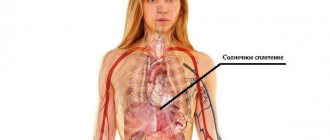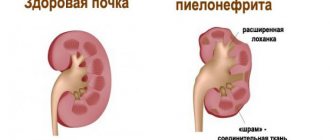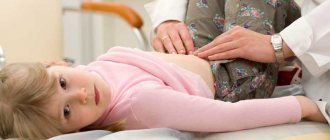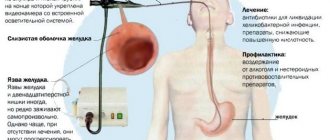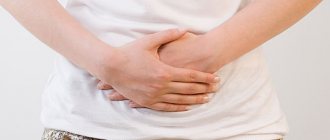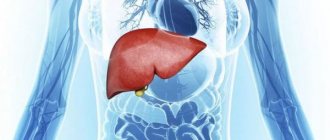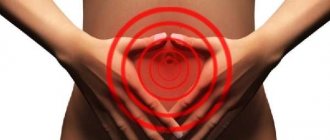Hello, dear readers! Let's talk today about one of the most important human organs - the kidneys, and specifically about what the symptoms of kidney disease are.
Although there are no extra organs in the body (as some believe), after removing, for example, the gallbladder, one can live quite tolerably, albeit following a diet, but life without both kidneys becomes completely impossible.
The kidneys are a filter in the human body. It’s hard to imagine, but it’s a fact: over the course of a day, the kidneys pass up to 2000 liters of blood through themselves, purifying and filtering it. The cleansing function (excretory) is the most important one, which the kidneys must cope with perfectly. They must remove from the blood metabolic end products that the body does not need, toxins, excess fluid, and mineral salts.
Of course, its other functions are vital for the body:
- kidneys help normalize blood pressure,
- production of a hormone involved in calcium metabolism,
- the kidneys synthesize a hormone that stimulates the creation of blood in the bone marrow,
- it is in the kidneys that the final conversion of vitamin D into its active form D3 occurs,
- kidneys take part in the processes of intermediate metabolism (meaning the exchange of lipids, carbohydrates, proteins),
- and also protects against the destructive effects of harmful substances (medicines, alcohol, nicotine), neutralizing and removing them.
When pathogens enter the body, the kidneys are the first to take the hit. This leads to their rapid inflammation. This means that determining the cause of the disease and supporting kidney health is of great importance.
Causes of pain in the kidneys
When the kidneys hurt, this indicates certain pathologies of the urinary system:
- inflammation of the glomeruli (the so-called glomerulonephritis, in chronic or acute form);
- another reason why the kidneys hurt is pyelonephritis (inflammation of the pyelocaliceal system), which can also be acute or chronic;
- urolithiasis (stones in the urinary system), when stones move through the urethra or are displaced;
- renal vascular thrombosis. It develops in patients with atherosclerosis, with embolism and thrombosis of blood vessels;
- polycystic disease and the accompanying cystic degeneration of the tissues of the affected organs. The structure of the kidney is almost completely destroyed. The formation of cysts with purulent contents, blood, etc. is also possible;
- mycobacterial organ damage (renal tuberculosis);
- nephroptosis – prolapse of the kidneys, up to their complete exit from their normal location. Organs can even descend into the pelvic cavity;
- tumor formations and other pathological growths that put pressure on the nerve endings and blood vessels of the kidneys;
- traumatic injuries with rupture of the renal capsule;
- in persons after transplantation - rejection of the donor organ due to an immune reaction to foreign, insufficiently compatible tissue.
Women's kidneys can also hurt for purely physiological reasons. Such pain does not require immediate medical intervention; all that is required is to monitor the patient’s condition.
Reasons for such conditions:
- Drinking too much liquid in a limited time. This creates an increased load on the kidneys, the amount of fluid entering them increases, and the glomerular apparatus ceases to cope with it. This provokes unpleasant sensations.
- Sports and physical activities that increase blood circulation. This puts a strain on both the kidneys and the liver, and generally creates a stressful situation for the body.
- Pregnancy. Most often, pain syndrome occurs in the first and third trimesters, when the fetus grows rapidly, increasing the size of the uterus of the expectant mother. The uterus, in turn, puts pressure on surrounding organs, including the kidneys, causing them to become painful.
The pain is localized on the right, left, or affects the entire lower back and lower abdomen.
Urolithiasis disease. What is urolithiasis?
Urolithiasis (UCD) is a disease of the urinary system, characterized by the formation and deposition of stones (calculi) of various etiologies in its parts.
The scientific name of the disease is urolithiasis.
Most often, the disease targets the kidneys and bladder, which is why the patient develops disorders characteristic of these organs in the form of renal colic and difficulties with urination. The consequence of urolithiasis is inflammatory processes in certain parts of the urinary system - nephritis, cystitis and other complications.
Some publications synonymize urolithiasis and nephrolithiasis, but it is worth specifying that nephrolithiasis, or nephrolithiasis (kidney stones), by localization, is a type of urolithiasis, which also includes ureterolithiasis (stones in the ureters) and cystolithiasis (stones in the bladder).
The main causes of urolithiasis are poor quality food, drinking too hard water, infections, metabolic disorders and the presence of various diseases of the genitourinary system.
Due to the peculiarities of ICD, it often has a long course with periodic exacerbations. And not the least culprit in the chronicle is the old habits of people to eat what they want or the lack of a special choice of food, which can also include the quality of water.
Development of the disease (pathogenesis)
The pathogenesis of renal colic is expressed by acute occlusion of the upper urinary tract, which causes an increase in pressure in the pyelocaliceal section of the kidney, which in turn leads to swelling of the parenchyma and stretching of the fibrous capsule of this organ. Due to the large number of baroreceptors in the pelvicalyceal region and the fibrous capsule of the kidney, pathological changes in the organ through the ThXI–LI segments of the spinal cord are notified by afferent impulses to the brain, which determines pain.
Statistics (epidemiology)
Today, urolithiasis does not have a clearly defined age group of patients and occurs in both 20 and 50-year-old men and women.
By gender, urolithiasis occurs more often in men than in women, however, in the latter, the disease is usually characterized by large stones, and therefore is often more severe.
By localization, there are more patients living in cities than in rural areas, which emphasizes the dependence of stone formation on the quality of water and food, as well as the ecological situation of residence.
There are no special borders by country; it is found both in the Middle East and Central Asia, as well as in South and North America, Australia, and Europe.
https://youtu.be/Umocifp9T1M
Risk factors
Pain syndrome is triggered by a variety of mechanisms, including:
- a woman may become ill with infectious lesions of the body. The focus of chronic infection becomes a breeding ground for pathogens that spread to neighboring organs and tissues. Among such infections, a woman may have adnexitis, salpingitis, etc.;
- diabetes and hypertension. Against the background of these pathologies, the patient’s blood vessels gradually degrade, and this also applies to the kidneys. Blood circulation is disrupted, the kidneys gradually lose their ability to filter out toxins and decrease in size;
- poor immunity. This is facilitated by HIV disease, undergoing radiation and chemotherapy procedures, taking immunosuppressants (after an organ transplant, for example), and other similar disorders;
- metabolic disorders in diseases of the adrenal glands, thyroid gland and other components of the internal secretion system;
- systematic hypothermia, including the legs. It is dangerous to stay in a draft for a long time, swim in cold water, or dress inappropriately for the season;
- poor nutrition. An inadequate diet, when the body feels a lack of minerals and vitamins, negatively affects the kidneys;
- dehydration;
- anatomical abnormalities of the kidneys and urinary tract;
- pain develops as a consequence of surgery (surgical removal of cysts, etc.);
- poor hygiene and multiple sexual contacts without proper means of protection;
- situation if a woman has suffered from sexually transmitted infections (or has a current pathology).
Among the causes of back pain there may be others that are not of renal origin; during diagnosis, the doctor must be able to analyze all the signs in order to choose the right therapeutic tactics.
Among these causes are disorders of the musculoskeletal system, their symptoms include:
- pain along the spine - they speak of damage to the latter, and are localized along its “midline”;
- unpleasant sensations in movement and when bending over are often caused by various musculoskeletal pathologies;
- pain radiating to the limbs and other areas of the body may indicate a pinched nerve;
- interruptions of nerve impulses, causing a decrease in sensitivity, “goosebumps”, etc.
In cases with pain of musculoskeletal origin, adopting a comfortable position reduces discomfort or even completely eliminates it. The intoxication syndrome inherent in acute inflammatory processes, as a rule, does not occur; body temperature also remains normal.
A comfortable position along with warming and analgesic ointments removes pain and restores the usual range of movements.
Symptoms
How do kidneys hurt in women? What signs are characteristic of disorders accompanied by pain in the kidneys? The genesis of renal pain syndrome can be very diverse, and is directly dependent on the primary pathology that gave rise to it: the type of pathology affecting the organs determines the clinical picture. The latter develops either suddenly or gradually, after sexual intercourse, intense exercise, hypothermia, etc. It is extremely important for the doctor to know what preceded the pain and what symptoms are present at the moment in order to make the correct diagnosis:
- The cause may be renal colic. How do you understand that it started? For such an attack, a typical symptom is acute, almost unbearable pain in the kidneys and abdomen in women. It occurs unexpectedly, taking the patient by surprise. The strength of the sensations is such that the patient can scream and moan loudly, rush around the room in an unconscious attempt to “escape” from the pain, and she can even vomit.
- Pain in the kidneys with damage to the glomeruli (pyelonephritis) is not so pronounced. It is usually aching, dull in nature, and can pulsate and ache throughout the day without changing intensity. If the patient lies on her healthy side (left, if the right kidney is affected, and vice versa, if the left), the pain subsides somewhat. Over time, as the inflammatory processes progress and swelling of the kidneys develops, the symptoms become stronger.
- Nephroptosis is accompanied by pain similar to that of pyelonephritis. The sensations are localized in the projection of the diseased organ (right or left kidney), are of a pulling nature and become stronger if the patient remains in an upright position for a long time. In the first stages, the discomfort goes away after rest, however, as the kidneys descend, the pain becomes stronger and worries the woman constantly - even in a supine position.
- Tumors are accompanied by disturbing phenomena of low intensity on the left or opposite side: if the left kidney hurts, sensations will be concentrated in its projection. As the degenerated tissue grows, the pain intensifies, as the tumor puts pressure on the nerve endings of the abdominal organs in women. In advanced stages, painful sensations become aching and constant, interfering with normal rest and sleep.
Other symptoms of diseased organs:
- temperature increase;
- general weakness and malaise;
- detection of harmful bacteria and leukocytes in urine samples;
- signs similar to cystitis: pain above the pubic area, frequent urination with pain.
Kidney pathologies in women are accompanied by more than just pain.
Some common signs of kidney problems:
- Patients often complain of high fever, weakness, malaise, loss of appetite and a number of other problems characteristic of intoxication;
- urinary disorders. It becomes more frequent, accompanied by pain and burning, and the patient may experience spasms. The color of urine also changes, it becomes cloudy, pus, bloody discharge and flakes are visually detected in it;
- The lower back on the affected side turns red and swells somewhat. Tapping in this place causes severe pain radiating to the thighs, lower abdomen and groin;
- the face may swell. As the disease progresses, the swelling “descends” to the arms, neck and beyond;
- pressure surges are observed;
- per day, less urine begins to be excreted compared to the norm, because kidney failure develops.
The patient loses weight and sweats profusely at night. Sweating is also observed during any physical activity, even minor ones. The condition is accompanied by attacks of nausea and some other symptoms.
How to determine kidney pain
Painful spasms in diseases of the reproductive system are localized in the organ area, lower back, under the lower ribs. The nature of the pain is aching, sharp, pulling, dull. The difficulty lies in determining the localization of spasms: from the kidneys, back. Unpleasant sensations of the urinary system manifest themselves in women as follows:
- the spasm is concentrated more often in 1 side;
- after anti-inflammatory drugs, pain persists;
- changing position does not reduce the intensity of the spasm;
- tapping on the organ provokes painful sensations inside.
Diagnostics
Therapy of pain in the kidney is a complex and complex process that requires, first of all, to establish the cause of the symptom (symptoms and treatment are closely related). Only a qualified doctor can determine why the kidneys hurt, so at the first signs of discomfort, it is advisable to contact a specialized specialist. How to determine that the kidneys hurt and what happened to them? Diagnosis is carried out by examining the patient, a set of laboratory tests and instrumental examinations:
- The strength of the pain and its localization are assessed: if, for example, it is concentrated in the right side, damage to the right kidney is likely. The doctor knows what pain can be in different cases;
- A general analysis of urine and blood samples taken from the patient is performed. It can be used to determine why the kidneys hurt - the presence of infectious agents in the body is determined, the number of inflammatory markers and other signs are assessed;
- Blood is taken for biochemical analysis, which is carried out without fail. The purpose of such diagnostics is to determine the level of total protein and protein fractions in the blood, to find out the presence and concentration of creatinine, urea, fibrinogen, etc.;
- Urine analysis using the Nechiporenko method. They count the number of red blood cells and leukocytes in urine sediment;
- bacterial culture is done. It is carried out to identify the causative agent of the disease, and is carried out before starting to take medications;
- carry out the urography procedure;
- the kidney is examined with ultrasound.
The most reliable method of diagnosing and establishing the cause of the disorder is computed tomography and magnetoresistive tomography, which gives the most accurate results.
Patient's actions
What should a woman do, which doctor should she see?
If you have pain in the kidney area, you should immediately consult a doctor, as it may indicate severe kidney pathology. Which doctor should I contact? Nephrologists and urologists treat these problems. These doctors conduct diagnostics, prescribe the necessary examination procedures for the patient and interpret the results, making a diagnosis. It is important to do this in a timely manner: patients often seek help late, at advanced stages of illness.
Having found out the cause of the ailment, the doctor prescribes therapy and gives recommendations for alleviating symptoms and, in fact, carrying out the therapy itself. Relatively mild conditions can be treated at home, but severe disorders may require hospitalization, including surgery.
Before visiting or visiting a doctor, you can try to give yourself first aid. If the patient has no doubt that the cause of the pain is the kidneys, and the doctor/emergency specialist confirmed this possibility in a telephone conversation, a number of measures can be taken. These include relieving kidney pain in women.
This can be done in the following ways:
- if your kidney hurts, take painkillers, provide rest to your body and try to rest;
- Additionally, you can take an antispasmodic medicine;
- Warmth has a pronounced calming effect. You can take a bath with warm water: it will help relax the muscles of the pelvis and ureter, relieving spasm and pain. Additionally, you can apply a warm heating pad to the body in the area where the kidneys are projected, holding it for some time;
- you need to monitor your temperature and try to prevent it from rising;
- Natural fruit juice, green tea or herbal drink will help you calm down and relax.
The doctor, having found out why one of the kidneys (or both) hurts, determines the optimal therapeutic strategy.
It may include anti-inflammatory and antimicrobial tablets, antipyretic drugs, uroseptics, and many other medications for kidney pain at the discretion of the treating specialist.
In addition, the fight against kidney disease involves some physiotherapeutic procedures, and in difficult cases, surgical intervention.
Prevention
The best way to treat any disease, including kidney disease, is to prevent its development. To prevent kidney pain and related ailments, patients should follow certain rules and make simple preventive measures part of their life:
- maintain a drinking regime. It is important to give the body enough fluid: an insufficient amount can provoke urolithiasis. Drinking generally means clean water; green tea and natural fruit drinks, juices, and compotes are also allowed. Black tea, coffee, carbonated drinks and alcohol are not included in this list. If enough water is supplied, it will naturally flush pathogens from the body. And fruit drinks have a beneficial effect on the kidneys due to a shift in the balance of urine towards oxidation. Most pathogens cannot survive in an acidic environment;
- You can drink herbal infusions and decoctions. They have a moderate diuretic effect, help fight inflammation and improve overall kidney health. Teas made from lingonberry, parsley or bearberry leaves perform well;
- in summer, it will be useful for women to eat watermelons - due to their diuretic effect and pulp containing a lot of water;
- In addition to drinking, diet is also important, its balance is very important. The diet must include sufficient amounts of all nutrients and elements. For example, a lack of fat can provoke kidney disorders; mono-diets are known to have a negative effect on organs. A kidney-friendly diet contains vegetables and fruits, seafood, and dairy products (containing vital methionine);
As a preventive measure, you can do light exercises on the lumbosacral spine, which also affects the kidneys.
https://youtu.be/mNGzdx5nGIM
Consequences of dysfunction of the urinary system
The kidney is a biological filter designed to quickly remove harmful substances and chemical compounds from the body. As soon as this system fails, toxins begin to accumulate in the blood, primarily affecting the functioning of the brain, heart and lungs.
The consequences may include the following diseases:
